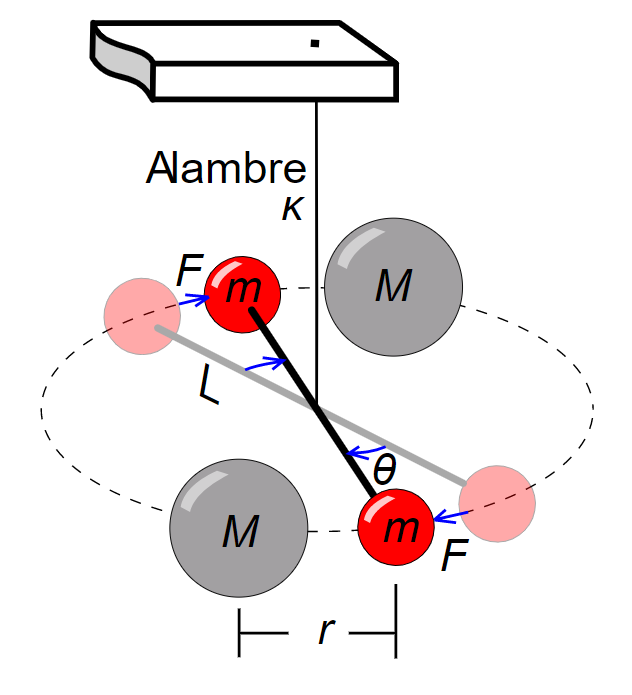
The value of gravitational constant G was first experimentally determined by:
A) Galileo
B) Newton
C) Cavendish
D) Kelvin
Answer
494.7k+ views
Hint: The value of gravitational constant, G first determined was
Complete step by step answer:
After nearly a century in 1798, Lord Henry Cavendish came to determine the value for that constant G by the experiment of torsional balance.

He attached the two small lead spheres in each side of the rod and the rod was suspended by a thin wire. When the rod is twisted, the torsion of the wire begins to exert the torsional force which is proportional to the angle of rotation. Then the more twisting leads the system to restore itself backward more. By this, Cavendish calculated the relationship between the angle of rotation to the amount of torsional force.
And then he brought two large spheres near to the small lead spheres connected to the rod. The large spheres exert the gravitational force on the small spheres which causes the rod to twist. Once the torsional force equals the gravitational force, the twisting stops. The rod comes to rest. Using this, Cavendish calculated the force of attraction. Then finally he determined the value of G.
Cavendish determined G as
Additional information:
(i)Sir Issac Newton in 1687, in his book philosophiae Naturalis Principia Mathematica discovered the term Gravitational constant for the first time while explaining the gravitational force.
(ii)Newton states that the gravitational force between any two objects is directly proportional to the product of their masses and inversely proportional to the square of the distance between their centres.
(iii) After nearly a century in 1798, Lord Henry Cavendish came to determine the value for that constant G by the experiment of torsional balance.
(vi) Cavendish determined G as
Note:
The gravitational force is the weakest of all forces in the universe. It has an appreciable value only if it is between the two objects having large masses.
Complete step by step answer:
After nearly a century in 1798, Lord Henry Cavendish came to determine the value for that constant G by the experiment of torsional balance.

He attached the two small lead spheres in each side of the rod and the rod was suspended by a thin wire. When the rod is twisted, the torsion of the wire begins to exert the torsional force which is proportional to the angle of rotation. Then the more twisting leads the system to restore itself backward more. By this, Cavendish calculated the relationship between the angle of rotation to the amount of torsional force.
And then he brought two large spheres near to the small lead spheres connected to the rod. The large spheres exert the gravitational force on the small spheres which causes the rod to twist. Once the torsional force equals the gravitational force, the twisting stops. The rod comes to rest. Using this, Cavendish calculated the force of attraction. Then finally he determined the value of G.
Cavendish determined G as
Additional information:
(i)Sir Issac Newton in 1687, in his book philosophiae Naturalis Principia Mathematica discovered the term Gravitational constant for the first time while explaining the gravitational force.
(ii)Newton states that the gravitational force between any two objects is directly proportional to the product of their masses and inversely proportional to the square of the distance between their centres.
(iii) After nearly a century in 1798, Lord Henry Cavendish came to determine the value for that constant G by the experiment of torsional balance.
(vi) Cavendish determined G as
Note:
The gravitational force is the weakest of all forces in the universe. It has an appreciable value only if it is between the two objects having large masses.
Recently Updated Pages
Master Class 11 Economics: Engaging Questions & Answers for Success

Master Class 11 Business Studies: Engaging Questions & Answers for Success

Master Class 11 Accountancy: Engaging Questions & Answers for Success

Master Class 11 English: Engaging Questions & Answers for Success

Master Class 11 Computer Science: Engaging Questions & Answers for Success

Master Class 11 Maths: Engaging Questions & Answers for Success

Trending doubts
State and prove Bernoullis theorem class 11 physics CBSE

What are Quantum numbers Explain the quantum number class 11 chemistry CBSE

Write the differences between monocot plants and dicot class 11 biology CBSE

Why is steel more elastic than rubber class 11 physics CBSE

Explain why a There is no atmosphere on the moon b class 11 physics CBSE

State the laws of reflection of light




